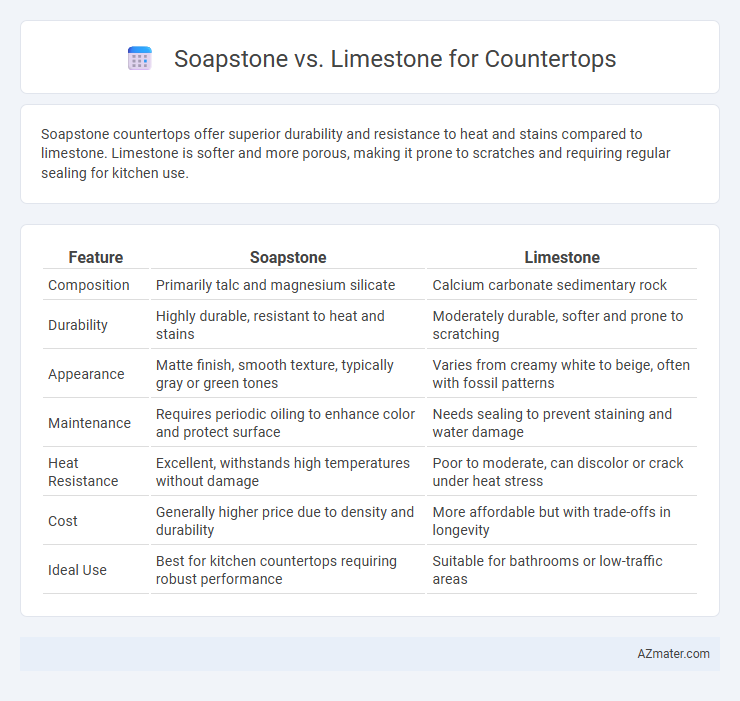Soapstone countertops offer superior durability and resistance to heat and stains compared to limestone. Limestone is softer and more porous, making it prone to scratches and requiring regular sealing for kitchen use.
Table of Comparison
| Feature | Soapstone | Limestone |
|---|---|---|
| Composition | Primarily talc and magnesium silicate | Calcium carbonate sedimentary rock |
| Durability | Highly durable, resistant to heat and stains | Moderately durable, softer and prone to scratching |
| Appearance | Matte finish, smooth texture, typically gray or green tones | Varies from creamy white to beige, often with fossil patterns |
| Maintenance | Requires periodic oiling to enhance color and protect surface | Needs sealing to prevent staining and water damage |
| Heat Resistance | Excellent, withstands high temperatures without damage | Poor to moderate, can discolor or crack under heat stress |
| Cost | Generally higher price due to density and durability | More affordable but with trade-offs in longevity |
| Ideal Use | Best for kitchen countertops requiring robust performance | Suitable for bathrooms or low-traffic areas |
Introduction to Soapstone and Limestone Countertops
Soapstone countertops offer exceptional durability and natural resistance to heat and stains, making them ideal for kitchens requiring low maintenance. Limestone countertops provide a softer, more porous surface with a warm, earthy aesthetic that enhances traditional and rustic interiors. Both materials require specific sealing and care routines to preserve their unique textures and longevity in culinary spaces.
Visual Appeal: Comparing Aesthetics
Soapstone countertops offer a smooth, matte finish with rich, deep tones ranging from dark gray to black, creating a timeless, elegant look. Limestone features softer, earthy hues such as beige, cream, and light gray with natural veining that adds warmth and a rustic charm to kitchen spaces. Both materials age beautifully, with soapstone developing a unique patina over time and limestone showcasing subtle color variations that enhance its natural beauty.
Durability and Strength Differences
Soapstone exhibits higher resistance to heat, stains, and acidic substances compared to limestone, making it more durable for countertop use. Limestone is softer and more porous, which increases its susceptibility to scratches, chips, and etching over time. The inherent density and composition of soapstone contribute to superior strength, ensuring longer-lasting surface integrity in kitchen environments.
Maintenance and Care Requirements
Soapstone countertops require minimal maintenance due to their non-porous nature, resisting stains and bacteria without the need for sealing, while occasional oiling enhances their natural patina. Limestone countertops, being porous, demand regular sealing to prevent staining and etching from acidic substances, and they require gentle cleaning with pH-neutral products to preserve their surface. Choosing soapstone offers durability and ease of care, whereas limestone needs consistent upkeep to maintain its aesthetic appeal.
Resistance to Stains and Chemicals
Soapstone countertops exhibit superior resistance to stains and chemicals due to their dense, non-porous structure, which prevents absorption of oils, acids, and other household substances. Limestone, being more porous and softer, is prone to staining and etching when exposed to acidic or alkaline substances, necessitating frequent sealing and careful maintenance. Choosing soapstone ensures a more durable and low-maintenance surface in kitchens and bathrooms exposed to food acids and cleaning agents.
Heat Resistance Comparison
Soapstone exhibits superior heat resistance compared to limestone, tolerating temperatures up to 1,200degF without damage, making it ideal for kitchen countertops exposed to hot pots and pans. Limestone, composed primarily of calcium carbonate, is more susceptible to heat damage and can develop cracks or discoloration at lower temperatures around 482degF. The non-porous nature and dense mineral composition of soapstone contribute to its durability under thermal stress, ensuring long-lasting performance in high-heat environments.
Cost and Affordability
Soapstone countertops generally cost between $70 and $120 per square foot, making them a mid-range option with good durability and resistance to heat and stains. Limestone is typically priced lower, around $40 to $70 per square foot, offering a budget-friendly alternative but with less hardness and higher susceptibility to scratches and acid damage. Considering installation and maintenance expenses, soapstone's longevity often offsets its higher upfront cost compared to the more affordable but softer limestone.
Environmental Impact and Sustainability
Soapstone countertops are highly sustainable due to their durability and low maintenance, requiring no harsh chemicals that can harm the environment. Limestone, while attractive, is less durable and often requires sealing and chemical treatments that may contribute to environmental degradation. Both materials are natural stones, but soapstone's longevity and minimal need for upkeep make it a more eco-friendly choice for countertop surfaces.
Ideal Applications and Design Styles
Soapstone countertops excel in kitchens with a rustic or traditional design, offering superior resistance to heat and stains while developing a natural patina over time, making them ideal for farmhouse or vintage-style homes. Limestone countertops suit contemporary or minimalist interiors, valued for their smooth, matte texture and subtle color variations, but require regular sealing due to their porous nature. Both materials provide distinct aesthetic and functional benefits, with soapstone favored for durability and heat resistance, and limestone preferred for elegance and softer visual appeal.
Final Verdict: Which Countertop Is Right for You?
Soapstone countertops offer superior heat resistance and a natural, smooth feel, while limestone provides a softer, more porous surface with subtle veining that develops character over time. Soapstone is ideal for homeowners seeking durability and low maintenance, whereas limestone suits those prioritizing aesthetic warmth but requiring more care to prevent staining. Choose soapstone for longevity and practicality, and limestone for a timeless, elegant look with gentle wear.

Infographic: Soapstone vs Limestone for Countertop
 azmater.com
azmater.com